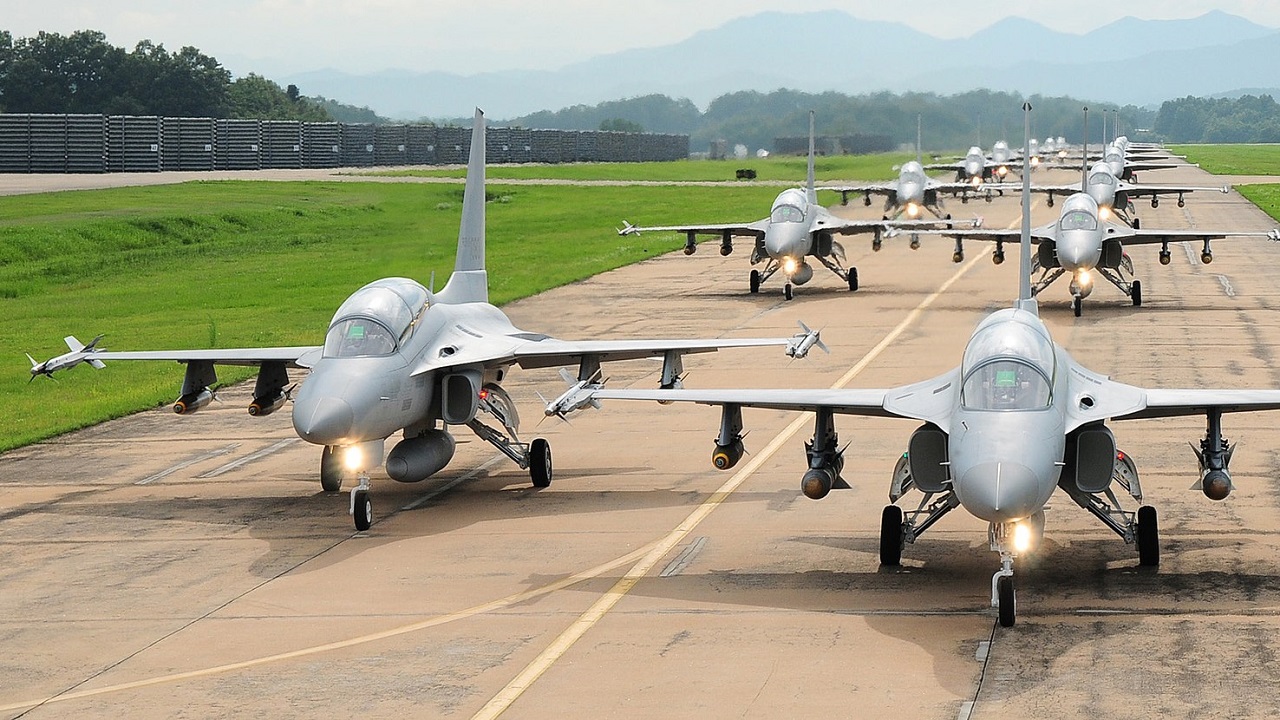The T-50, Explained: The People’s Republic of China (PRC) and the Democratic People’s Republic of Korea (DPRK) aka North Korea, are seemingly getting more and more belligerent with each passing day.
The PRC under Xi Jinping, in addition to its never-ending military expansion and modernization, combined with repression of its own citizens, has for all practices entered into a veritable Unholy Alliance with Vladimir Putin’s revanchist Russia.
Meanwhile, the DPRK’s Kim Jong Un has ramped up ballistic missile tests as well as the bellicosity of his verbal saber-rattling. Bearing all this in mind, the role of the Republic of Korea (ROK), aka South Korea, as a key U.S. ally in the INDOPACOM region is more vital than ever. Much like another key INDOPACOM ally, India, the ROK largely relies on foreign imports to supply its Air Force. However, like India is doing vis-a-vis its Tejas light combat aircraft program, South Korea is also developing a more self-reliant homegrown Air Force, and the primary vehicle (bad pun intended) for that venture toward self-reliance is the KAI T-50 Golden Eagle. Let’s now take a closer look at the T-50 and its capabilities.
The ROK’s Golden Eagle
The two-seater T-50 Golden Eagle (황금 독수리 / hwang-geum dogsuli) is a joint venture between Korea Aerospace Industries (KAI) and Lockheed Martin, however, unlike many other Lockheed Martin warbirds that 19FortyFive authors have written about recently, this one is not part of their famed Skunk Works program.
Development began in the mid-1990s, with the costs being split 17 percent by KAI, 13 percent by Lockheed Martin, and 70 percent by the Korean government. Designed as both an advanced supersonic jet trainer as well as a light combat aircraft, the Golden Eagle made her maiden flight on August 20, 2002, and officially went operational on February 22, 2005, thus officially becoming South Korea’s first indigenous supersonic aircraft (max airspeed Mach 1.5/1,148mph/1,837.5kph/992..2 knots).
In accordance with the light combat aircraft designation, the T-50 has a length of 43.1 feet (13.14 meters), a height of 15.8 feet (4.81 meters), and a wingspan of 31 feet (9.45 meters). It bears a maximum takeoff weight of 23,638 pounds.
Mainly a Trainer and Demonstrated, But Also Combat-Proven
As a testament to the baseline T-50’s versatility, KAI has produced multiple versions of the Golden Eagle that can be tailored to a variety of mission needs. For starters, there is the T-50B, which is used solely by the ROK Air Force’s (ROKAF) “Black Eagles” demonstration team, which is the ROKAF’s equivalent of the U.S. Navy Blue Angels, USAF Thunderbirds, and RAF Red Arrows.
Next, there is the TA-50, which is normally used as a trainer, although if required it can be used as a light attack aircraft. The Iraqi Air Force (IqAF) is indeed using this variant for the latter role, officially re-dubbing it the T-50IQ, using it to supplement its inventory of F-16s, Sukhoi Su-25 Frogfoots (or would that be “Frogfeet?), and Czech-made Aero L-159s.
As noted by Forbes contributor Paul Iddon, “The T-50IQ can carry much of the same missiles and bombs Iraq’s F-16s can, including Joint Direct Attack Munitions (JDAMs) and ‘dumb’ bombs like the Mk. 82. Furthermore, the its [sic] targeting computer and radar can guide dumb bombs ‘with a high degree of accuracy,’ making the T-50IQ ideal for the role coalition advisors suggested the L-159 could fulfill.” After a seemingly interminable series of delays — the IqAF had originally ordered 24 of the warbirds back in 2013 with deliveries intended to begin in 2016 — the T-50IQs finally went operational last month.
And then there is the FA-50 lightweight multi-role fighter. This version is already combat-proven, thanks to the 12 planes acquired by the Philippine Air Force (PAF). According to an official Philippine News Agency press release, “The FA-50PH aircraft had its baptism of fire in the Marawi City campaign where it was heavily used for close-air support mission roles along with the venerable OV-10 ‘Bronco’ turbo-prop attack aircraft, SF-260 light bombers, and various attack helicopters of the PAF. It has a top speed of Mach 1.5 or one and a half times the speed of sound and is capable of being fitted with air-to-air missiles, including the AIM-9 ‘Sidewinder’ air-to-air and heat-seeking missiles aside from light automatic cannons, and bombs.”
The press release also notes that the PAF is hoping to acquire more of these Golden Eagles, quoting PAF chief Lt. Gen. Connor Anthony Canlas Sr. accordingly: “‘Yes, it is an option. The FA-50s is a good lead-in trainer fighter aircraft na rin, halos multi-role, pwede siyang mag-air-to-ground (it can be considered almost as a multi-role aircraft as it can do air-to-ground missions) or air-to-air. It provides a good training opportunity for the pilots to step up to higher performance aircraft.'”
Salamat-po, Shukran, and Kamsa Hamnida (that’s “Thank you” in Tagalog, Arabic, and Korean respectively), Golden Eagle!
Christian D. Orr is a former Air Force officer, Federal law enforcement officer, and private military contractor (with assignments worked in Iraq, the United Arab Emirates, Kosovo, Japan, Germany, and the Pentagon). Chris holds a B.A. in International Relations from the University of Southern California (USC) and an M.A. in Intelligence Studies (concentration in Terrorism Studies) from American Military University (AMU). He has also been published in The Daily Torch and The Journal of Intelligence and Cyber Security. Last but not least, he is a Companion of the Order of the Naval Order of the United States (NOUS).

